Essay on Indian Cooking: Vegetarianism in Hindu Religion
VerifiedAdded on 2022/10/09
|15
|4532
|226
Essay
AI Summary
This research essay delves into the world of Indian vegetarian cooking, focusing on its socio-cultural aspects and particularly its connection to the Hindu religion. The essay traces the historical development of Indian cuisine, highlighting influences from various cultures and trade interactions. It examines the staple foods, ingredients, and the prominent use of spices that characterize Indian vegetarian dishes. The essay also explores the reasons behind the predominantly vegetarian dietary practices in India, emphasizing the religious and cultural significance, especially the influence of Hinduism. It provides an overview of common vegetarian dishes, their preparation methods, and their cultural context. The essay also covers the historical evolution of Indian cuisine, including the impact of invasions, mobility, and the influences of other cultures on Indian food diversity. The essay also looks at various vegetarian dishes like Malai Kofta, Palak Paneer, Rajma and other popular dishes in Indian Cuisine. The essay offers a comprehensive understanding of Indian gastronomy, its culinary practices, and its deep-rooted cultural significance.
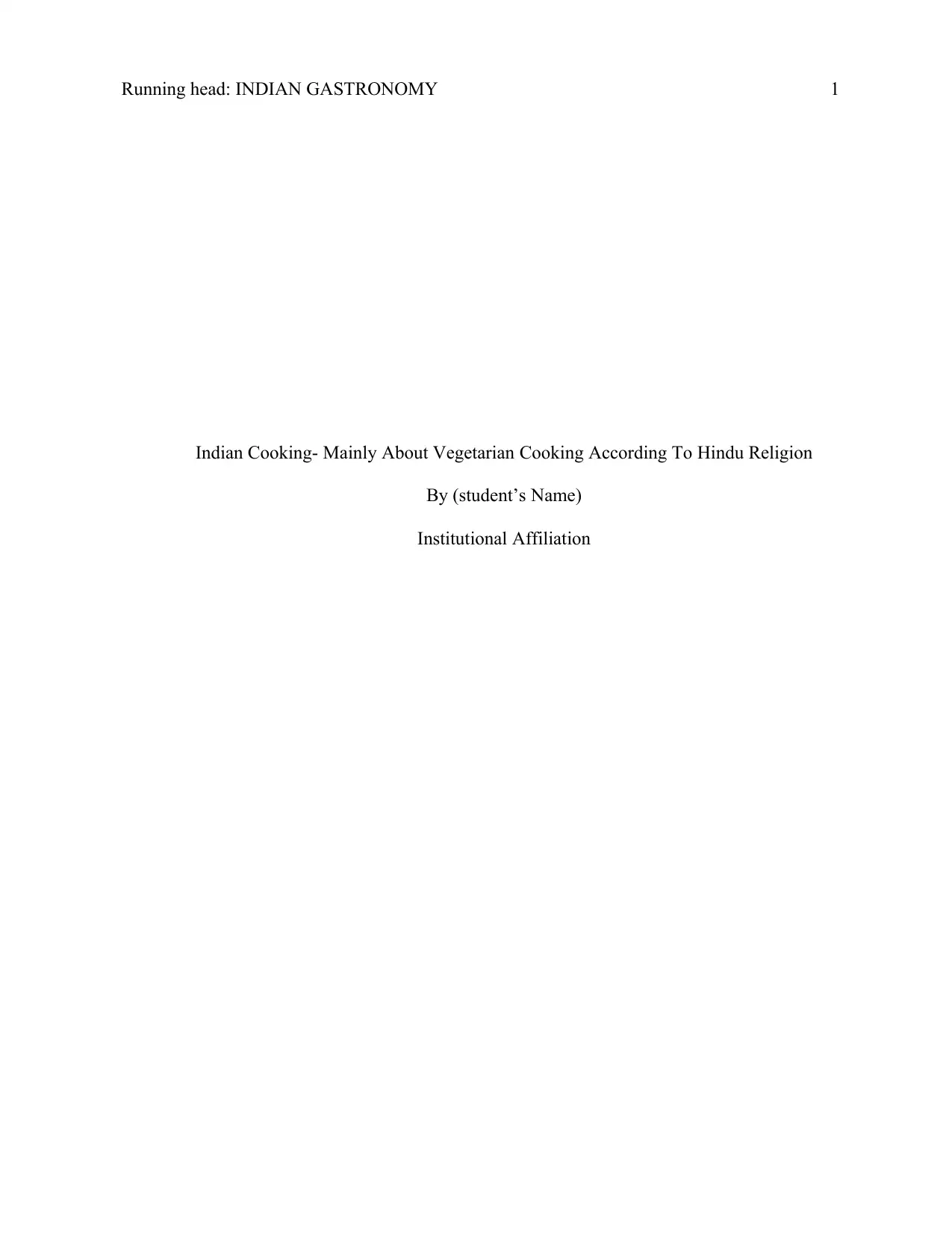
Running head: INDIAN GASTRONOMY 1
Indian Cooking- Mainly About Vegetarian Cooking According To Hindu Religion
By (student’s Name)
Institutional Affiliation
Indian Cooking- Mainly About Vegetarian Cooking According To Hindu Religion
By (student’s Name)
Institutional Affiliation
Paraphrase This Document
Need a fresh take? Get an instant paraphrase of this document with our AI Paraphraser
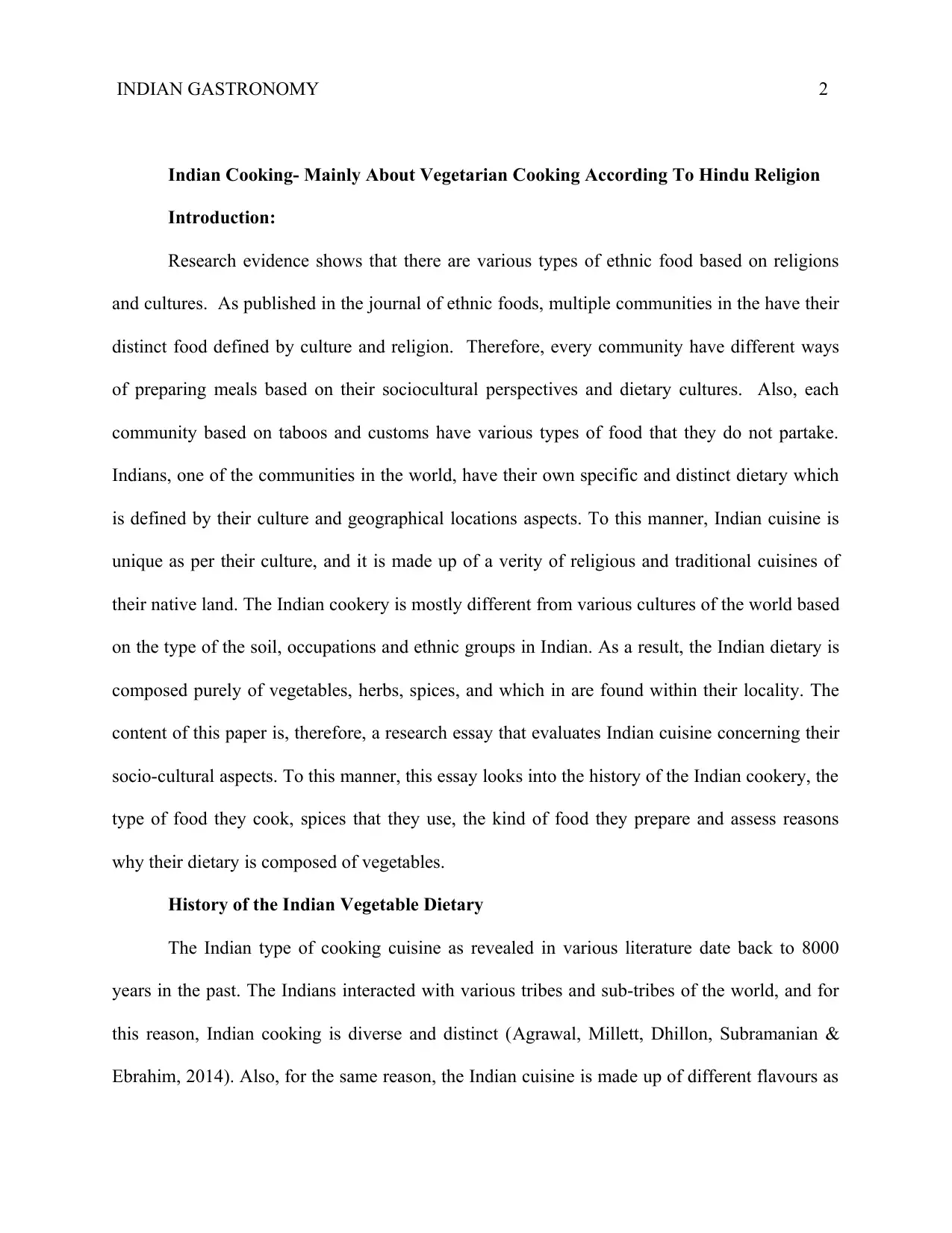
INDIAN GASTRONOMY 2
Indian Cooking- Mainly About Vegetarian Cooking According To Hindu Religion
Introduction:
Research evidence shows that there are various types of ethnic food based on religions
and cultures. As published in the journal of ethnic foods, multiple communities in the have their
distinct food defined by culture and religion. Therefore, every community have different ways
of preparing meals based on their sociocultural perspectives and dietary cultures. Also, each
community based on taboos and customs have various types of food that they do not partake.
Indians, one of the communities in the world, have their own specific and distinct dietary which
is defined by their culture and geographical locations aspects. To this manner, Indian cuisine is
unique as per their culture, and it is made up of a verity of religious and traditional cuisines of
their native land. The Indian cookery is mostly different from various cultures of the world based
on the type of the soil, occupations and ethnic groups in Indian. As a result, the Indian dietary is
composed purely of vegetables, herbs, spices, and which in are found within their locality. The
content of this paper is, therefore, a research essay that evaluates Indian cuisine concerning their
socio-cultural aspects. To this manner, this essay looks into the history of the Indian cookery, the
type of food they cook, spices that they use, the kind of food they prepare and assess reasons
why their dietary is composed of vegetables.
History of the Indian Vegetable Dietary
The Indian type of cooking cuisine as revealed in various literature date back to 8000
years in the past. The Indians interacted with various tribes and sub-tribes of the world, and for
this reason, Indian cooking is diverse and distinct (Agrawal, Millett, Dhillon, Subramanian &
Ebrahim, 2014). Also, for the same reason, the Indian cuisine is made up of different flavours as
Indian Cooking- Mainly About Vegetarian Cooking According To Hindu Religion
Introduction:
Research evidence shows that there are various types of ethnic food based on religions
and cultures. As published in the journal of ethnic foods, multiple communities in the have their
distinct food defined by culture and religion. Therefore, every community have different ways
of preparing meals based on their sociocultural perspectives and dietary cultures. Also, each
community based on taboos and customs have various types of food that they do not partake.
Indians, one of the communities in the world, have their own specific and distinct dietary which
is defined by their culture and geographical locations aspects. To this manner, Indian cuisine is
unique as per their culture, and it is made up of a verity of religious and traditional cuisines of
their native land. The Indian cookery is mostly different from various cultures of the world based
on the type of the soil, occupations and ethnic groups in Indian. As a result, the Indian dietary is
composed purely of vegetables, herbs, spices, and which in are found within their locality. The
content of this paper is, therefore, a research essay that evaluates Indian cuisine concerning their
socio-cultural aspects. To this manner, this essay looks into the history of the Indian cookery, the
type of food they cook, spices that they use, the kind of food they prepare and assess reasons
why their dietary is composed of vegetables.
History of the Indian Vegetable Dietary
The Indian type of cooking cuisine as revealed in various literature date back to 8000
years in the past. The Indians interacted with various tribes and sub-tribes of the world, and for
this reason, Indian cooking is diverse and distinct (Agrawal, Millett, Dhillon, Subramanian &
Ebrahim, 2014). Also, for the same reason, the Indian cuisine is made up of different flavours as
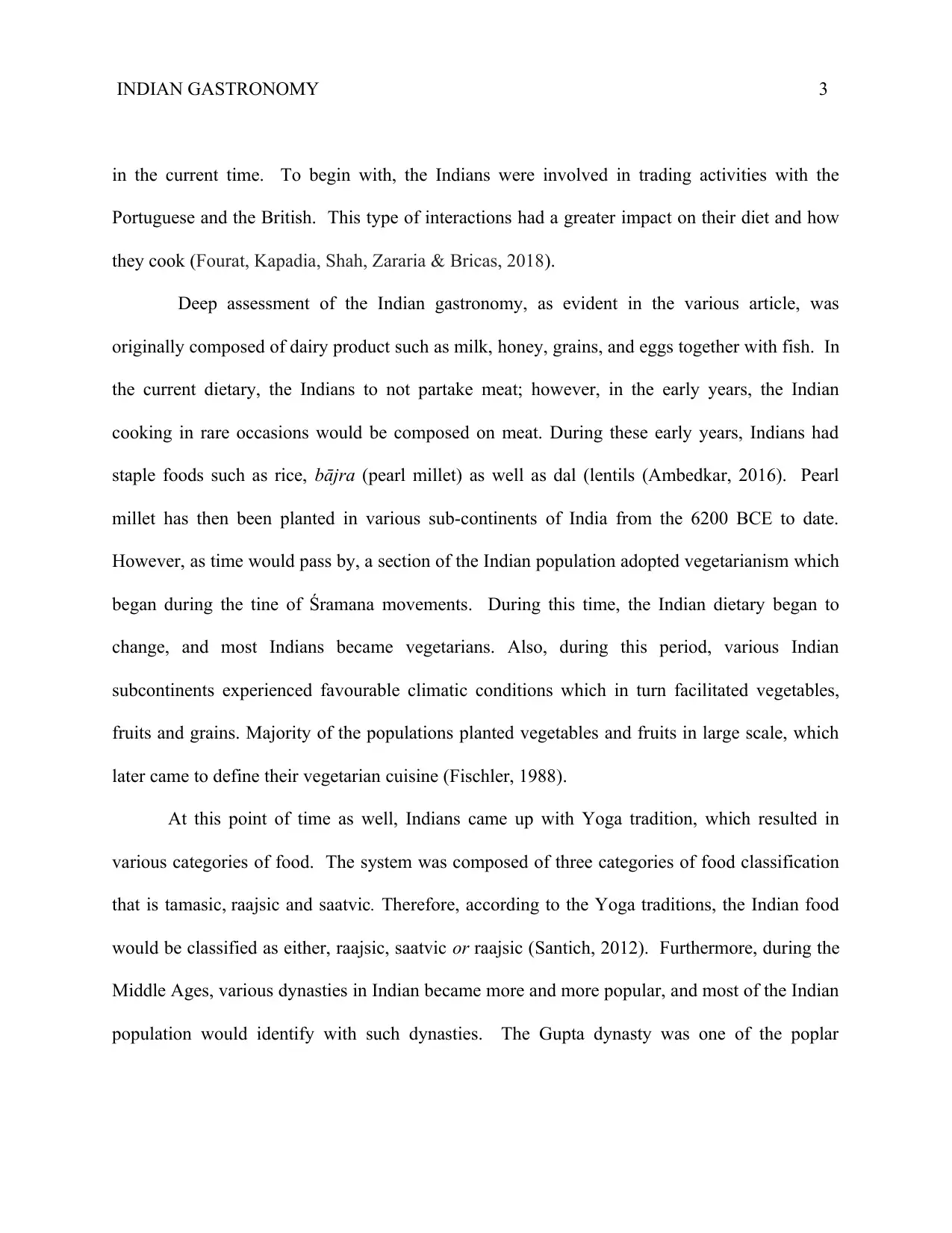
INDIAN GASTRONOMY 3
in the current time. To begin with, the Indians were involved in trading activities with the
Portuguese and the British. This type of interactions had a greater impact on their diet and how
they cook (Fourat, Kapadia, Shah, Zararia & Bricas, 2018).
Deep assessment of the Indian gastronomy, as evident in the various article, was
originally composed of dairy product such as milk, honey, grains, and eggs together with fish. In
the current dietary, the Indians to not partake meat; however, in the early years, the Indian
cooking in rare occasions would be composed on meat. During these early years, Indians had
staple foods such as rice, bājra (pearl millet) as well as dal (lentils (Ambedkar, 2016). Pearl
millet has then been planted in various sub-continents of India from the 6200 BCE to date.
However, as time would pass by, a section of the Indian population adopted vegetarianism which
began during the tine of Śramana movements. During this time, the Indian dietary began to
change, and most Indians became vegetarians. Also, during this period, various Indian
subcontinents experienced favourable climatic conditions which in turn facilitated vegetables,
fruits and grains. Majority of the populations planted vegetables and fruits in large scale, which
later came to define their vegetarian cuisine (Fischler, 1988).
At this point of time as well, Indians came up with Yoga tradition, which resulted in
various categories of food. The system was composed of three categories of food classification
that is tamasic, raajsic and saatvic. Therefore, according to the Yoga traditions, the Indian food
would be classified as either, raajsic, saatvic or raajsic (Santich, 2012). Furthermore, during the
Middle Ages, various dynasties in Indian became more and more popular, and most of the Indian
population would identify with such dynasties. The Gupta dynasty was one of the poplar
in the current time. To begin with, the Indians were involved in trading activities with the
Portuguese and the British. This type of interactions had a greater impact on their diet and how
they cook (Fourat, Kapadia, Shah, Zararia & Bricas, 2018).
Deep assessment of the Indian gastronomy, as evident in the various article, was
originally composed of dairy product such as milk, honey, grains, and eggs together with fish. In
the current dietary, the Indians to not partake meat; however, in the early years, the Indian
cooking in rare occasions would be composed on meat. During these early years, Indians had
staple foods such as rice, bājra (pearl millet) as well as dal (lentils (Ambedkar, 2016). Pearl
millet has then been planted in various sub-continents of India from the 6200 BCE to date.
However, as time would pass by, a section of the Indian population adopted vegetarianism which
began during the tine of Śramana movements. During this time, the Indian dietary began to
change, and most Indians became vegetarians. Also, during this period, various Indian
subcontinents experienced favourable climatic conditions which in turn facilitated vegetables,
fruits and grains. Majority of the populations planted vegetables and fruits in large scale, which
later came to define their vegetarian cuisine (Fischler, 1988).
At this point of time as well, Indians came up with Yoga tradition, which resulted in
various categories of food. The system was composed of three categories of food classification
that is tamasic, raajsic and saatvic. Therefore, according to the Yoga traditions, the Indian food
would be classified as either, raajsic, saatvic or raajsic (Santich, 2012). Furthermore, during the
Middle Ages, various dynasties in Indian became more and more popular, and most of the Indian
population would identify with such dynasties. The Gupta dynasty was one of the poplar
⊘ This is a preview!⊘
Do you want full access?
Subscribe today to unlock all pages.

Trusted by 1+ million students worldwide
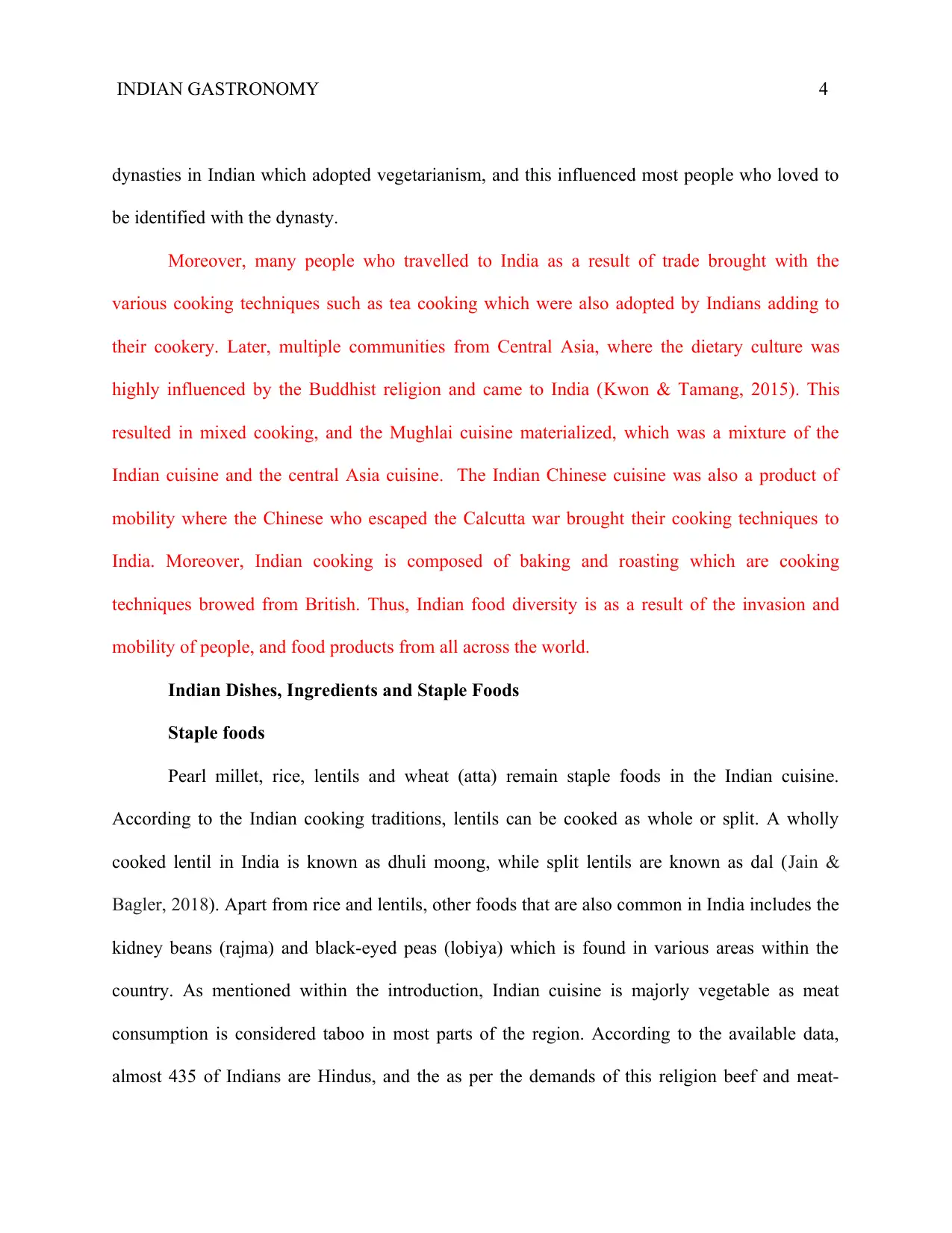
INDIAN GASTRONOMY 4
dynasties in Indian which adopted vegetarianism, and this influenced most people who loved to
be identified with the dynasty.
Moreover, many people who travelled to India as a result of trade brought with the
various cooking techniques such as tea cooking which were also adopted by Indians adding to
their cookery. Later, multiple communities from Central Asia, where the dietary culture was
highly influenced by the Buddhist religion and came to India (Kwon & Tamang, 2015). This
resulted in mixed cooking, and the Mughlai cuisine materialized, which was a mixture of the
Indian cuisine and the central Asia cuisine. The Indian Chinese cuisine was also a product of
mobility where the Chinese who escaped the Calcutta war brought their cooking techniques to
India. Moreover, Indian cooking is composed of baking and roasting which are cooking
techniques browed from British. Thus, Indian food diversity is as a result of the invasion and
mobility of people, and food products from all across the world.
Indian Dishes, Ingredients and Staple Foods
Staple foods
Pearl millet, rice, lentils and wheat (atta) remain staple foods in the Indian cuisine.
According to the Indian cooking traditions, lentils can be cooked as whole or split. A wholly
cooked lentil in India is known as dhuli moong, while split lentils are known as dal (Jain &
Bagler, 2018). Apart from rice and lentils, other foods that are also common in India includes the
kidney beans (rajma) and black-eyed peas (lobiya) which is found in various areas within the
country. As mentioned within the introduction, Indian cuisine is majorly vegetable as meat
consumption is considered taboo in most parts of the region. According to the available data,
almost 435 of Indians are Hindus, and the as per the demands of this religion beef and meat-
dynasties in Indian which adopted vegetarianism, and this influenced most people who loved to
be identified with the dynasty.
Moreover, many people who travelled to India as a result of trade brought with the
various cooking techniques such as tea cooking which were also adopted by Indians adding to
their cookery. Later, multiple communities from Central Asia, where the dietary culture was
highly influenced by the Buddhist religion and came to India (Kwon & Tamang, 2015). This
resulted in mixed cooking, and the Mughlai cuisine materialized, which was a mixture of the
Indian cuisine and the central Asia cuisine. The Indian Chinese cuisine was also a product of
mobility where the Chinese who escaped the Calcutta war brought their cooking techniques to
India. Moreover, Indian cooking is composed of baking and roasting which are cooking
techniques browed from British. Thus, Indian food diversity is as a result of the invasion and
mobility of people, and food products from all across the world.
Indian Dishes, Ingredients and Staple Foods
Staple foods
Pearl millet, rice, lentils and wheat (atta) remain staple foods in the Indian cuisine.
According to the Indian cooking traditions, lentils can be cooked as whole or split. A wholly
cooked lentil in India is known as dhuli moong, while split lentils are known as dal (Jain &
Bagler, 2018). Apart from rice and lentils, other foods that are also common in India includes the
kidney beans (rajma) and black-eyed peas (lobiya) which is found in various areas within the
country. As mentioned within the introduction, Indian cuisine is majorly vegetable as meat
consumption is considered taboo in most parts of the region. According to the available data,
almost 435 of Indians are Hindus, and the as per the demands of this religion beef and meat-
Paraphrase This Document
Need a fresh take? Get an instant paraphrase of this document with our AI Paraphraser
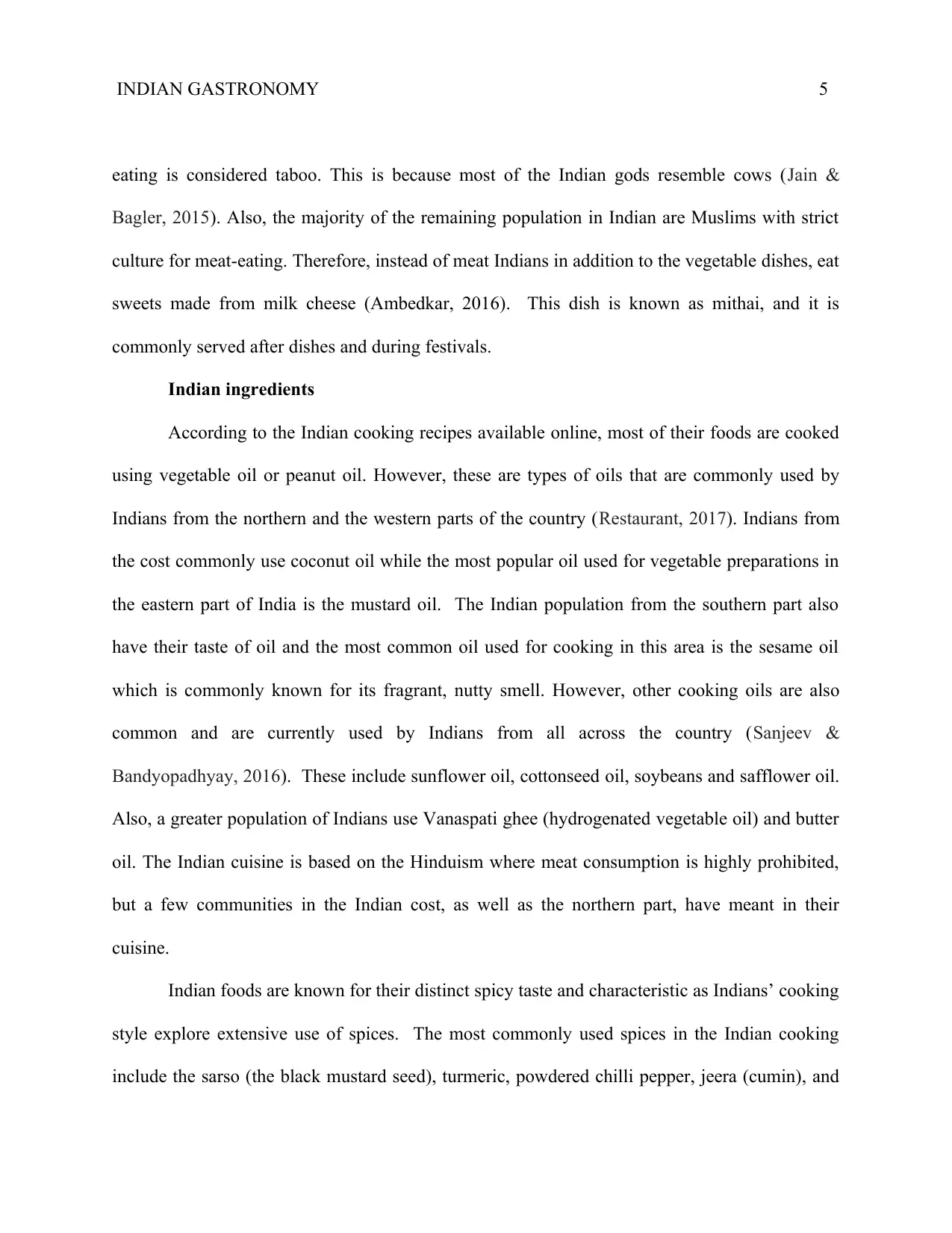
INDIAN GASTRONOMY 5
eating is considered taboo. This is because most of the Indian gods resemble cows (Jain &
Bagler, 2015). Also, the majority of the remaining population in Indian are Muslims with strict
culture for meat-eating. Therefore, instead of meat Indians in addition to the vegetable dishes, eat
sweets made from milk cheese (Ambedkar, 2016). This dish is known as mithai, and it is
commonly served after dishes and during festivals.
Indian ingredients
According to the Indian cooking recipes available online, most of their foods are cooked
using vegetable oil or peanut oil. However, these are types of oils that are commonly used by
Indians from the northern and the western parts of the country (Restaurant, 2017). Indians from
the cost commonly use coconut oil while the most popular oil used for vegetable preparations in
the eastern part of India is the mustard oil. The Indian population from the southern part also
have their taste of oil and the most common oil used for cooking in this area is the sesame oil
which is commonly known for its fragrant, nutty smell. However, other cooking oils are also
common and are currently used by Indians from all across the country (Sanjeev &
Bandyopadhyay, 2016). These include sunflower oil, cottonseed oil, soybeans and safflower oil.
Also, a greater population of Indians use Vanaspati ghee (hydrogenated vegetable oil) and butter
oil. The Indian cuisine is based on the Hinduism where meat consumption is highly prohibited,
but a few communities in the Indian cost, as well as the northern part, have meant in their
cuisine.
Indian foods are known for their distinct spicy taste and characteristic as Indians’ cooking
style explore extensive use of spices. The most commonly used spices in the Indian cooking
include the sarso (the black mustard seed), turmeric, powdered chilli pepper, jeera (cumin), and
eating is considered taboo. This is because most of the Indian gods resemble cows (Jain &
Bagler, 2015). Also, the majority of the remaining population in Indian are Muslims with strict
culture for meat-eating. Therefore, instead of meat Indians in addition to the vegetable dishes, eat
sweets made from milk cheese (Ambedkar, 2016). This dish is known as mithai, and it is
commonly served after dishes and during festivals.
Indian ingredients
According to the Indian cooking recipes available online, most of their foods are cooked
using vegetable oil or peanut oil. However, these are types of oils that are commonly used by
Indians from the northern and the western parts of the country (Restaurant, 2017). Indians from
the cost commonly use coconut oil while the most popular oil used for vegetable preparations in
the eastern part of India is the mustard oil. The Indian population from the southern part also
have their taste of oil and the most common oil used for cooking in this area is the sesame oil
which is commonly known for its fragrant, nutty smell. However, other cooking oils are also
common and are currently used by Indians from all across the country (Sanjeev &
Bandyopadhyay, 2016). These include sunflower oil, cottonseed oil, soybeans and safflower oil.
Also, a greater population of Indians use Vanaspati ghee (hydrogenated vegetable oil) and butter
oil. The Indian cuisine is based on the Hinduism where meat consumption is highly prohibited,
but a few communities in the Indian cost, as well as the northern part, have meant in their
cuisine.
Indian foods are known for their distinct spicy taste and characteristic as Indians’ cooking
style explore extensive use of spices. The most commonly used spices in the Indian cooking
include the sarso (the black mustard seed), turmeric, powdered chilli pepper, jeera (cumin), and
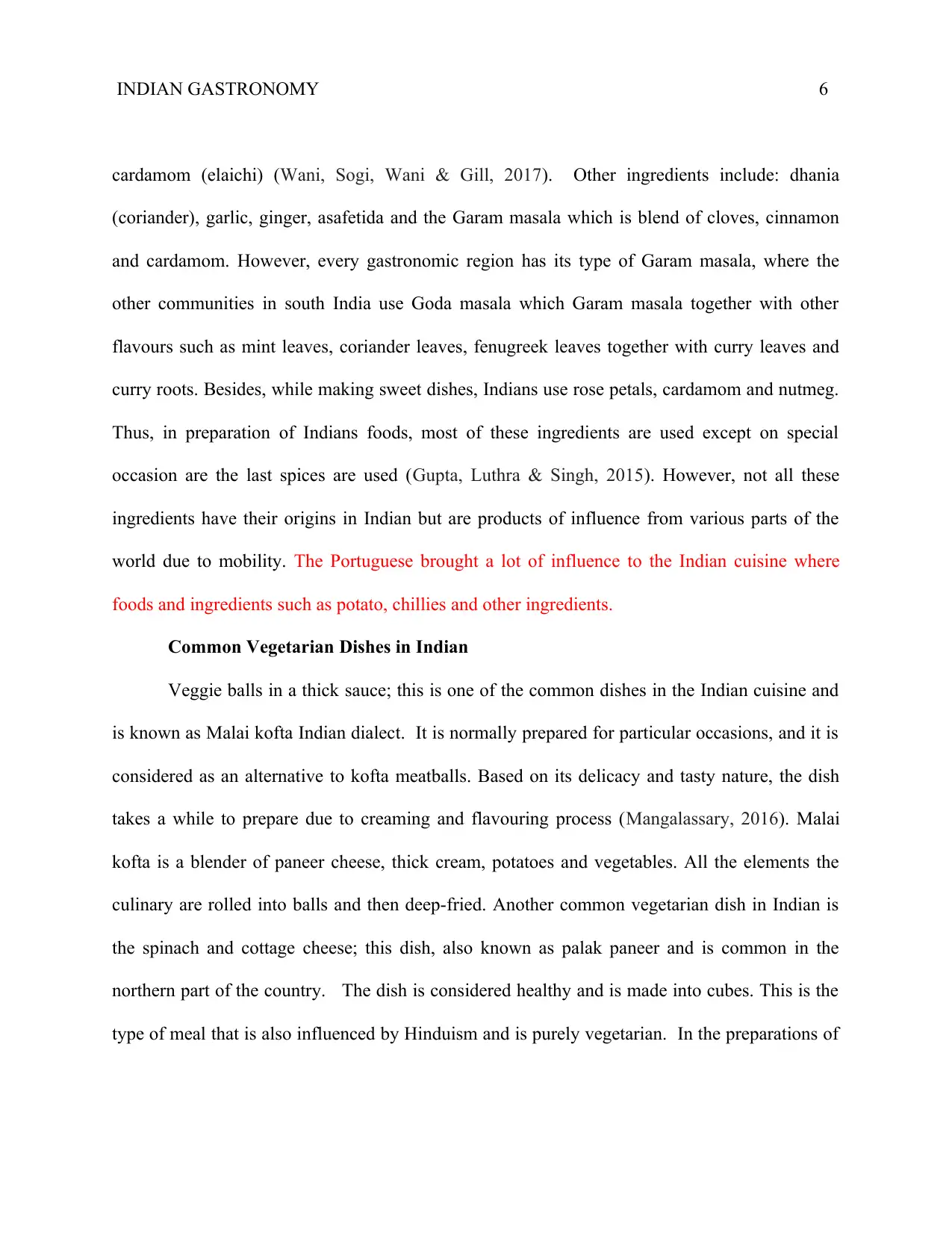
INDIAN GASTRONOMY 6
cardamom (elaichi) (Wani, Sogi, Wani & Gill, 2017). Other ingredients include: dhania
(coriander), garlic, ginger, asafetida and the Garam masala which is blend of cloves, cinnamon
and cardamom. However, every gastronomic region has its type of Garam masala, where the
other communities in south India use Goda masala which Garam masala together with other
flavours such as mint leaves, coriander leaves, fenugreek leaves together with curry leaves and
curry roots. Besides, while making sweet dishes, Indians use rose petals, cardamom and nutmeg.
Thus, in preparation of Indians foods, most of these ingredients are used except on special
occasion are the last spices are used (Gupta, Luthra & Singh, 2015). However, not all these
ingredients have their origins in Indian but are products of influence from various parts of the
world due to mobility. The Portuguese brought a lot of influence to the Indian cuisine where
foods and ingredients such as potato, chillies and other ingredients.
Common Vegetarian Dishes in Indian
Veggie balls in a thick sauce; this is one of the common dishes in the Indian cuisine and
is known as Malai kofta Indian dialect. It is normally prepared for particular occasions, and it is
considered as an alternative to kofta meatballs. Based on its delicacy and tasty nature, the dish
takes a while to prepare due to creaming and flavouring process (Mangalassary, 2016). Malai
kofta is a blender of paneer cheese, thick cream, potatoes and vegetables. All the elements the
culinary are rolled into balls and then deep-fried. Another common vegetarian dish in Indian is
the spinach and cottage cheese; this dish, also known as palak paneer and is common in the
northern part of the country. The dish is considered healthy and is made into cubes. This is the
type of meal that is also influenced by Hinduism and is purely vegetarian. In the preparations of
cardamom (elaichi) (Wani, Sogi, Wani & Gill, 2017). Other ingredients include: dhania
(coriander), garlic, ginger, asafetida and the Garam masala which is blend of cloves, cinnamon
and cardamom. However, every gastronomic region has its type of Garam masala, where the
other communities in south India use Goda masala which Garam masala together with other
flavours such as mint leaves, coriander leaves, fenugreek leaves together with curry leaves and
curry roots. Besides, while making sweet dishes, Indians use rose petals, cardamom and nutmeg.
Thus, in preparation of Indians foods, most of these ingredients are used except on special
occasion are the last spices are used (Gupta, Luthra & Singh, 2015). However, not all these
ingredients have their origins in Indian but are products of influence from various parts of the
world due to mobility. The Portuguese brought a lot of influence to the Indian cuisine where
foods and ingredients such as potato, chillies and other ingredients.
Common Vegetarian Dishes in Indian
Veggie balls in a thick sauce; this is one of the common dishes in the Indian cuisine and
is known as Malai kofta Indian dialect. It is normally prepared for particular occasions, and it is
considered as an alternative to kofta meatballs. Based on its delicacy and tasty nature, the dish
takes a while to prepare due to creaming and flavouring process (Mangalassary, 2016). Malai
kofta is a blender of paneer cheese, thick cream, potatoes and vegetables. All the elements the
culinary are rolled into balls and then deep-fried. Another common vegetarian dish in Indian is
the spinach and cottage cheese; this dish, also known as palak paneer and is common in the
northern part of the country. The dish is considered healthy and is made into cubes. This is the
type of meal that is also influenced by Hinduism and is purely vegetarian. In the preparations of
⊘ This is a preview!⊘
Do you want full access?
Subscribe today to unlock all pages.

Trusted by 1+ million students worldwide
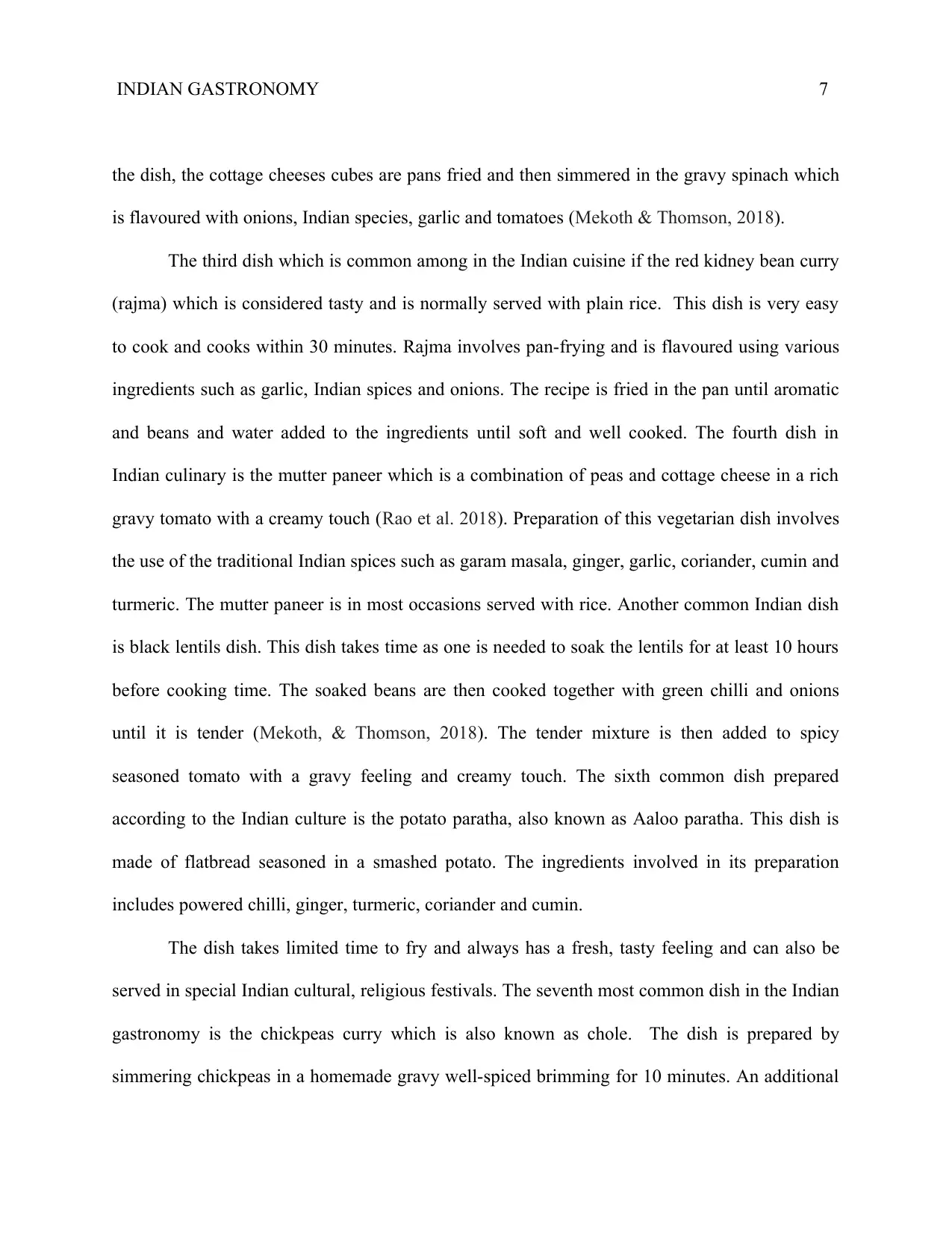
INDIAN GASTRONOMY 7
the dish, the cottage cheeses cubes are pans fried and then simmered in the gravy spinach which
is flavoured with onions, Indian species, garlic and tomatoes (Mekoth & Thomson, 2018).
The third dish which is common among in the Indian cuisine if the red kidney bean curry
(rajma) which is considered tasty and is normally served with plain rice. This dish is very easy
to cook and cooks within 30 minutes. Rajma involves pan-frying and is flavoured using various
ingredients such as garlic, Indian spices and onions. The recipe is fried in the pan until aromatic
and beans and water added to the ingredients until soft and well cooked. The fourth dish in
Indian culinary is the mutter paneer which is a combination of peas and cottage cheese in a rich
gravy tomato with a creamy touch (Rao et al. 2018). Preparation of this vegetarian dish involves
the use of the traditional Indian spices such as garam masala, ginger, garlic, coriander, cumin and
turmeric. The mutter paneer is in most occasions served with rice. Another common Indian dish
is black lentils dish. This dish takes time as one is needed to soak the lentils for at least 10 hours
before cooking time. The soaked beans are then cooked together with green chilli and onions
until it is tender (Mekoth, & Thomson, 2018). The tender mixture is then added to spicy
seasoned tomato with a gravy feeling and creamy touch. The sixth common dish prepared
according to the Indian culture is the potato paratha, also known as Aaloo paratha. This dish is
made of flatbread seasoned in a smashed potato. The ingredients involved in its preparation
includes powered chilli, ginger, turmeric, coriander and cumin.
The dish takes limited time to fry and always has a fresh, tasty feeling and can also be
served in special Indian cultural, religious festivals. The seventh most common dish in the Indian
gastronomy is the chickpeas curry which is also known as chole. The dish is prepared by
simmering chickpeas in a homemade gravy well-spiced brimming for 10 minutes. An additional
the dish, the cottage cheeses cubes are pans fried and then simmered in the gravy spinach which
is flavoured with onions, Indian species, garlic and tomatoes (Mekoth & Thomson, 2018).
The third dish which is common among in the Indian cuisine if the red kidney bean curry
(rajma) which is considered tasty and is normally served with plain rice. This dish is very easy
to cook and cooks within 30 minutes. Rajma involves pan-frying and is flavoured using various
ingredients such as garlic, Indian spices and onions. The recipe is fried in the pan until aromatic
and beans and water added to the ingredients until soft and well cooked. The fourth dish in
Indian culinary is the mutter paneer which is a combination of peas and cottage cheese in a rich
gravy tomato with a creamy touch (Rao et al. 2018). Preparation of this vegetarian dish involves
the use of the traditional Indian spices such as garam masala, ginger, garlic, coriander, cumin and
turmeric. The mutter paneer is in most occasions served with rice. Another common Indian dish
is black lentils dish. This dish takes time as one is needed to soak the lentils for at least 10 hours
before cooking time. The soaked beans are then cooked together with green chilli and onions
until it is tender (Mekoth, & Thomson, 2018). The tender mixture is then added to spicy
seasoned tomato with a gravy feeling and creamy touch. The sixth common dish prepared
according to the Indian culture is the potato paratha, also known as Aaloo paratha. This dish is
made of flatbread seasoned in a smashed potato. The ingredients involved in its preparation
includes powered chilli, ginger, turmeric, coriander and cumin.
The dish takes limited time to fry and always has a fresh, tasty feeling and can also be
served in special Indian cultural, religious festivals. The seventh most common dish in the Indian
gastronomy is the chickpeas curry which is also known as chole. The dish is prepared by
simmering chickpeas in a homemade gravy well-spiced brimming for 10 minutes. An additional
Paraphrase This Document
Need a fresh take? Get an instant paraphrase of this document with our AI Paraphraser
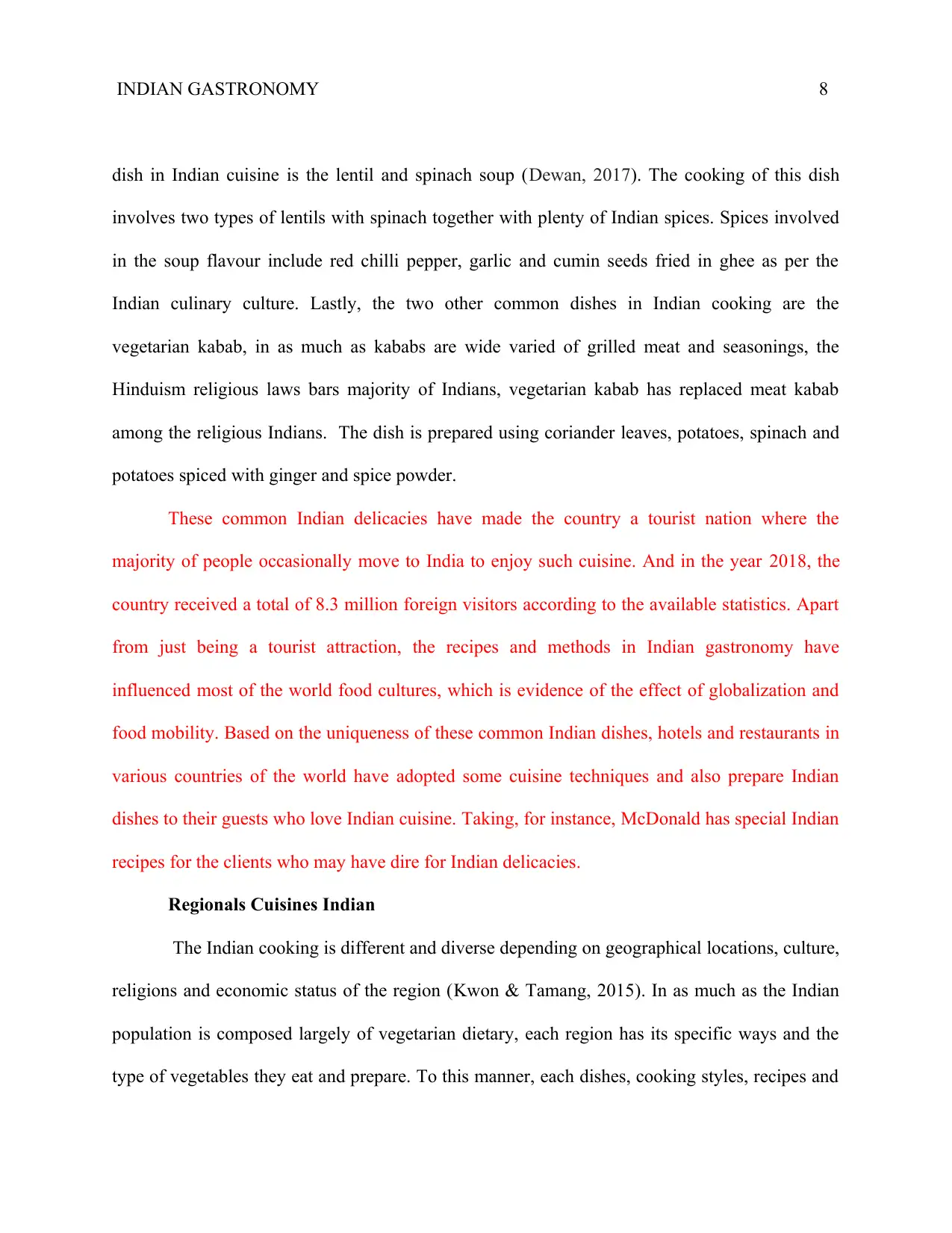
INDIAN GASTRONOMY 8
dish in Indian cuisine is the lentil and spinach soup (Dewan, 2017). The cooking of this dish
involves two types of lentils with spinach together with plenty of Indian spices. Spices involved
in the soup flavour include red chilli pepper, garlic and cumin seeds fried in ghee as per the
Indian culinary culture. Lastly, the two other common dishes in Indian cooking are the
vegetarian kabab, in as much as kababs are wide varied of grilled meat and seasonings, the
Hinduism religious laws bars majority of Indians, vegetarian kabab has replaced meat kabab
among the religious Indians. The dish is prepared using coriander leaves, potatoes, spinach and
potatoes spiced with ginger and spice powder.
These common Indian delicacies have made the country a tourist nation where the
majority of people occasionally move to India to enjoy such cuisine. And in the year 2018, the
country received a total of 8.3 million foreign visitors according to the available statistics. Apart
from just being a tourist attraction, the recipes and methods in Indian gastronomy have
influenced most of the world food cultures, which is evidence of the effect of globalization and
food mobility. Based on the uniqueness of these common Indian dishes, hotels and restaurants in
various countries of the world have adopted some cuisine techniques and also prepare Indian
dishes to their guests who love Indian cuisine. Taking, for instance, McDonald has special Indian
recipes for the clients who may have dire for Indian delicacies.
Regionals Cuisines Indian
The Indian cooking is different and diverse depending on geographical locations, culture,
religions and economic status of the region (Kwon & Tamang, 2015). In as much as the Indian
population is composed largely of vegetarian dietary, each region has its specific ways and the
type of vegetables they eat and prepare. To this manner, each dishes, cooking styles, recipes and
dish in Indian cuisine is the lentil and spinach soup (Dewan, 2017). The cooking of this dish
involves two types of lentils with spinach together with plenty of Indian spices. Spices involved
in the soup flavour include red chilli pepper, garlic and cumin seeds fried in ghee as per the
Indian culinary culture. Lastly, the two other common dishes in Indian cooking are the
vegetarian kabab, in as much as kababs are wide varied of grilled meat and seasonings, the
Hinduism religious laws bars majority of Indians, vegetarian kabab has replaced meat kabab
among the religious Indians. The dish is prepared using coriander leaves, potatoes, spinach and
potatoes spiced with ginger and spice powder.
These common Indian delicacies have made the country a tourist nation where the
majority of people occasionally move to India to enjoy such cuisine. And in the year 2018, the
country received a total of 8.3 million foreign visitors according to the available statistics. Apart
from just being a tourist attraction, the recipes and methods in Indian gastronomy have
influenced most of the world food cultures, which is evidence of the effect of globalization and
food mobility. Based on the uniqueness of these common Indian dishes, hotels and restaurants in
various countries of the world have adopted some cuisine techniques and also prepare Indian
dishes to their guests who love Indian cuisine. Taking, for instance, McDonald has special Indian
recipes for the clients who may have dire for Indian delicacies.
Regionals Cuisines Indian
The Indian cooking is different and diverse depending on geographical locations, culture,
religions and economic status of the region (Kwon & Tamang, 2015). In as much as the Indian
population is composed largely of vegetarian dietary, each region has its specific ways and the
type of vegetables they eat and prepare. To this manner, each dishes, cooking styles, recipes and
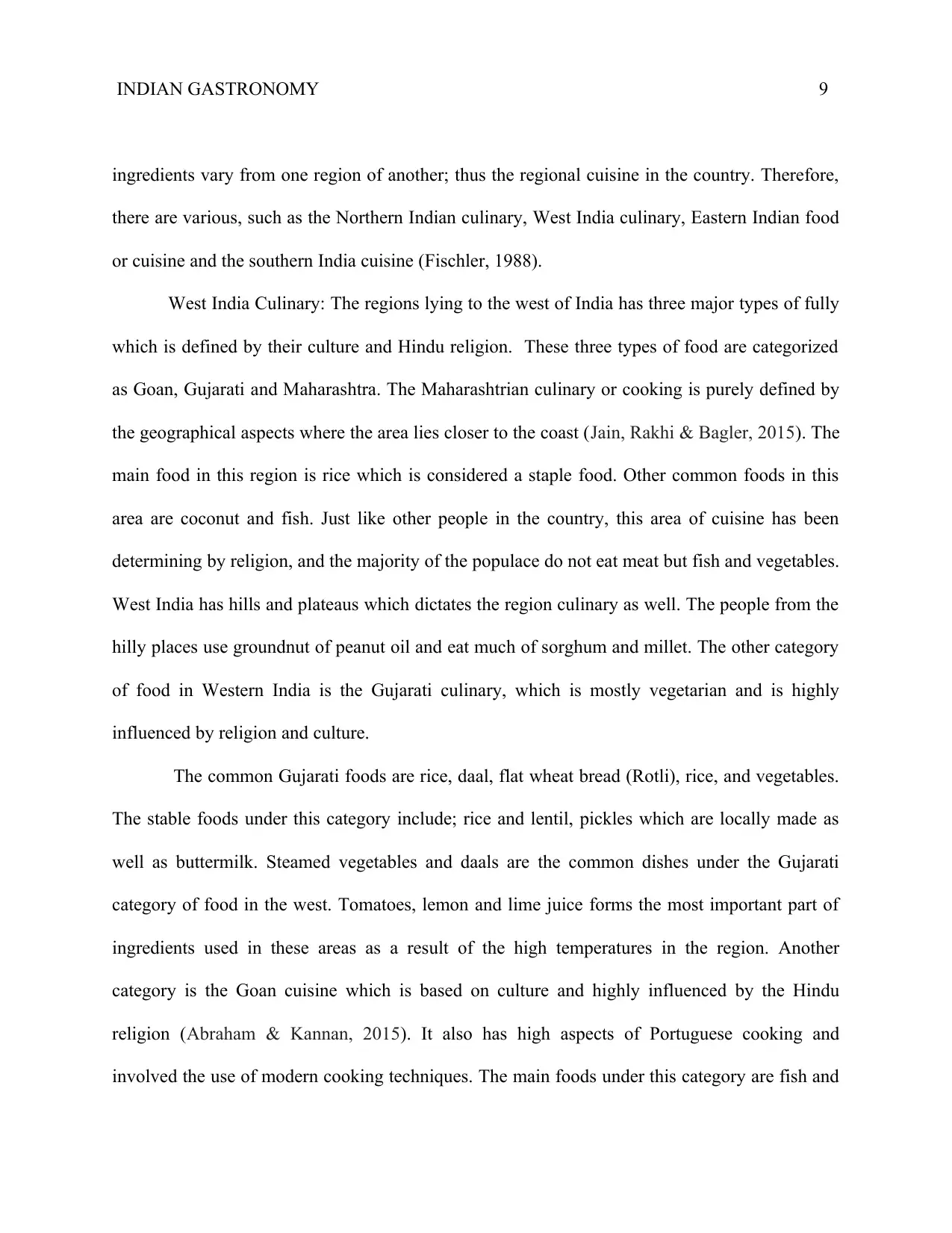
INDIAN GASTRONOMY 9
ingredients vary from one region of another; thus the regional cuisine in the country. Therefore,
there are various, such as the Northern Indian culinary, West India culinary, Eastern Indian food
or cuisine and the southern India cuisine (Fischler, 1988).
West India Culinary: The regions lying to the west of India has three major types of fully
which is defined by their culture and Hindu religion. These three types of food are categorized
as Goan, Gujarati and Maharashtra. The Maharashtrian culinary or cooking is purely defined by
the geographical aspects where the area lies closer to the coast (Jain, Rakhi & Bagler, 2015). The
main food in this region is rice which is considered a staple food. Other common foods in this
area are coconut and fish. Just like other people in the country, this area of cuisine has been
determining by religion, and the majority of the populace do not eat meat but fish and vegetables.
West India has hills and plateaus which dictates the region culinary as well. The people from the
hilly places use groundnut of peanut oil and eat much of sorghum and millet. The other category
of food in Western India is the Gujarati culinary, which is mostly vegetarian and is highly
influenced by religion and culture.
The common Gujarati foods are rice, daal, flat wheat bread (Rotli), rice, and vegetables.
The stable foods under this category include; rice and lentil, pickles which are locally made as
well as buttermilk. Steamed vegetables and daals are the common dishes under the Gujarati
category of food in the west. Tomatoes, lemon and lime juice forms the most important part of
ingredients used in these areas as a result of the high temperatures in the region. Another
category is the Goan cuisine which is based on culture and highly influenced by the Hindu
religion (Abraham & Kannan, 2015). It also has high aspects of Portuguese cooking and
involved the use of modern cooking techniques. The main foods under this category are fish and
ingredients vary from one region of another; thus the regional cuisine in the country. Therefore,
there are various, such as the Northern Indian culinary, West India culinary, Eastern Indian food
or cuisine and the southern India cuisine (Fischler, 1988).
West India Culinary: The regions lying to the west of India has three major types of fully
which is defined by their culture and Hindu religion. These three types of food are categorized
as Goan, Gujarati and Maharashtra. The Maharashtrian culinary or cooking is purely defined by
the geographical aspects where the area lies closer to the coast (Jain, Rakhi & Bagler, 2015). The
main food in this region is rice which is considered a staple food. Other common foods in this
area are coconut and fish. Just like other people in the country, this area of cuisine has been
determining by religion, and the majority of the populace do not eat meat but fish and vegetables.
West India has hills and plateaus which dictates the region culinary as well. The people from the
hilly places use groundnut of peanut oil and eat much of sorghum and millet. The other category
of food in Western India is the Gujarati culinary, which is mostly vegetarian and is highly
influenced by religion and culture.
The common Gujarati foods are rice, daal, flat wheat bread (Rotli), rice, and vegetables.
The stable foods under this category include; rice and lentil, pickles which are locally made as
well as buttermilk. Steamed vegetables and daals are the common dishes under the Gujarati
category of food in the west. Tomatoes, lemon and lime juice forms the most important part of
ingredients used in these areas as a result of the high temperatures in the region. Another
category is the Goan cuisine which is based on culture and highly influenced by the Hindu
religion (Abraham & Kannan, 2015). It also has high aspects of Portuguese cooking and
involved the use of modern cooking techniques. The main foods under this category are fish and
⊘ This is a preview!⊘
Do you want full access?
Subscribe today to unlock all pages.

Trusted by 1+ million students worldwide
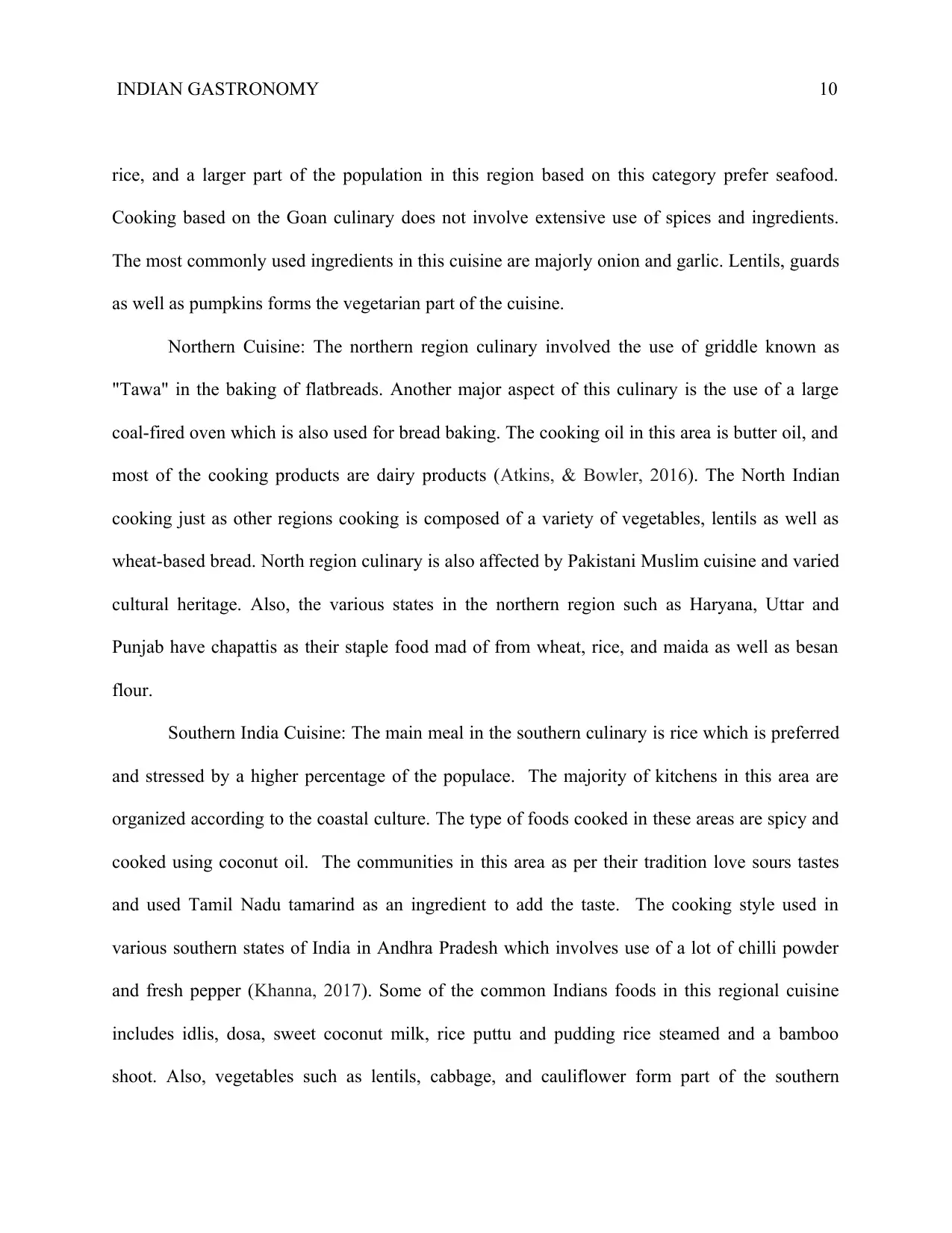
INDIAN GASTRONOMY 10
rice, and a larger part of the population in this region based on this category prefer seafood.
Cooking based on the Goan culinary does not involve extensive use of spices and ingredients.
The most commonly used ingredients in this cuisine are majorly onion and garlic. Lentils, guards
as well as pumpkins forms the vegetarian part of the cuisine.
Northern Cuisine: The northern region culinary involved the use of griddle known as
"Tawa" in the baking of flatbreads. Another major aspect of this culinary is the use of a large
coal-fired oven which is also used for bread baking. The cooking oil in this area is butter oil, and
most of the cooking products are dairy products (Atkins, & Bowler, 2016). The North Indian
cooking just as other regions cooking is composed of a variety of vegetables, lentils as well as
wheat-based bread. North region culinary is also affected by Pakistani Muslim cuisine and varied
cultural heritage. Also, the various states in the northern region such as Haryana, Uttar and
Punjab have chapattis as their staple food mad of from wheat, rice, and maida as well as besan
flour.
Southern India Cuisine: The main meal in the southern culinary is rice which is preferred
and stressed by a higher percentage of the populace. The majority of kitchens in this area are
organized according to the coastal culture. The type of foods cooked in these areas are spicy and
cooked using coconut oil. The communities in this area as per their tradition love sours tastes
and used Tamil Nadu tamarind as an ingredient to add the taste. The cooking style used in
various southern states of India in Andhra Pradesh which involves use of a lot of chilli powder
and fresh pepper (Khanna, 2017). Some of the common Indians foods in this regional cuisine
includes idlis, dosa, sweet coconut milk, rice puttu and pudding rice steamed and a bamboo
shoot. Also, vegetables such as lentils, cabbage, and cauliflower form part of the southern
rice, and a larger part of the population in this region based on this category prefer seafood.
Cooking based on the Goan culinary does not involve extensive use of spices and ingredients.
The most commonly used ingredients in this cuisine are majorly onion and garlic. Lentils, guards
as well as pumpkins forms the vegetarian part of the cuisine.
Northern Cuisine: The northern region culinary involved the use of griddle known as
"Tawa" in the baking of flatbreads. Another major aspect of this culinary is the use of a large
coal-fired oven which is also used for bread baking. The cooking oil in this area is butter oil, and
most of the cooking products are dairy products (Atkins, & Bowler, 2016). The North Indian
cooking just as other regions cooking is composed of a variety of vegetables, lentils as well as
wheat-based bread. North region culinary is also affected by Pakistani Muslim cuisine and varied
cultural heritage. Also, the various states in the northern region such as Haryana, Uttar and
Punjab have chapattis as their staple food mad of from wheat, rice, and maida as well as besan
flour.
Southern India Cuisine: The main meal in the southern culinary is rice which is preferred
and stressed by a higher percentage of the populace. The majority of kitchens in this area are
organized according to the coastal culture. The type of foods cooked in these areas are spicy and
cooked using coconut oil. The communities in this area as per their tradition love sours tastes
and used Tamil Nadu tamarind as an ingredient to add the taste. The cooking style used in
various southern states of India in Andhra Pradesh which involves use of a lot of chilli powder
and fresh pepper (Khanna, 2017). Some of the common Indians foods in this regional cuisine
includes idlis, dosa, sweet coconut milk, rice puttu and pudding rice steamed and a bamboo
shoot. Also, vegetables such as lentils, cabbage, and cauliflower form part of the southern
Paraphrase This Document
Need a fresh take? Get an instant paraphrase of this document with our AI Paraphraser
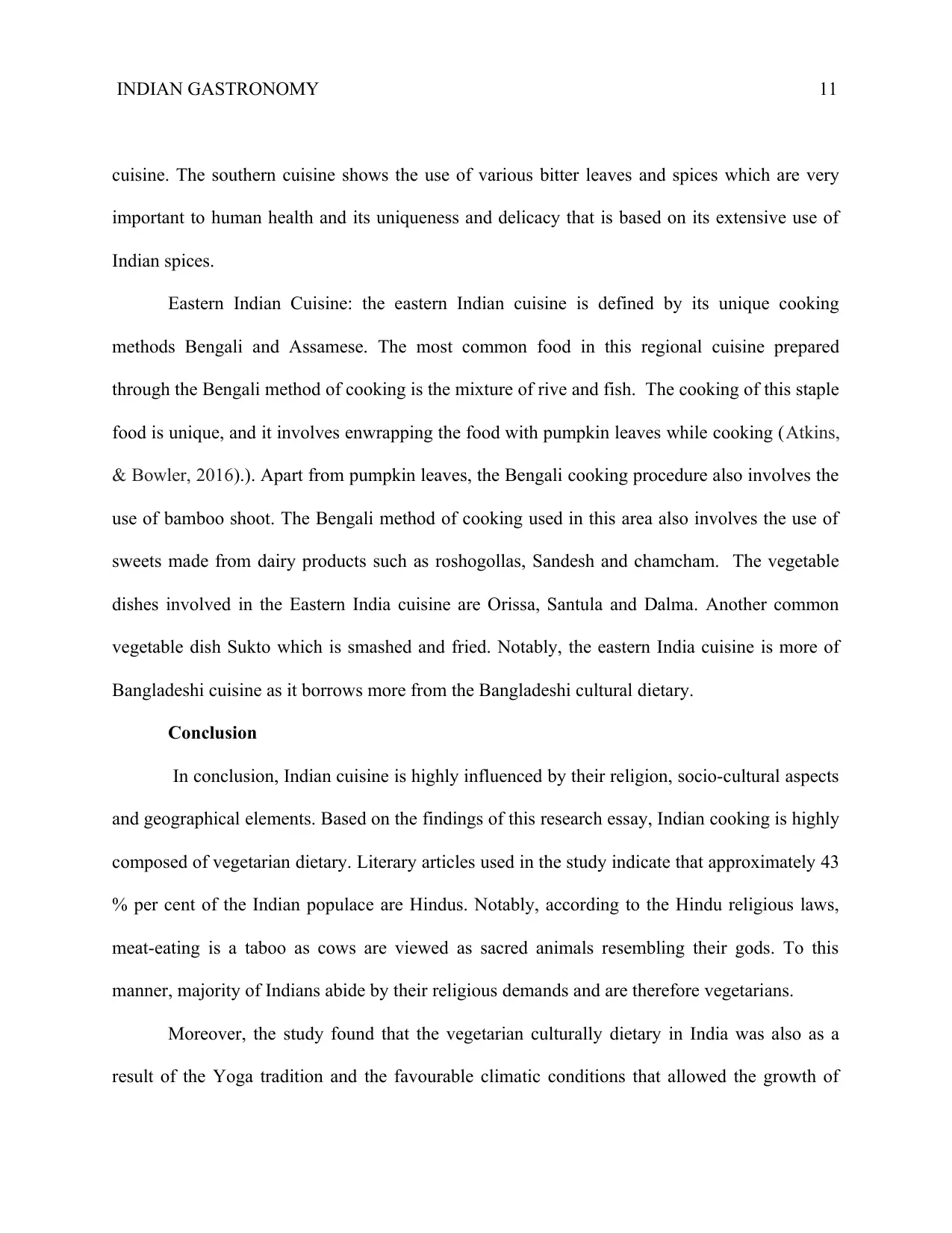
INDIAN GASTRONOMY 11
cuisine. The southern cuisine shows the use of various bitter leaves and spices which are very
important to human health and its uniqueness and delicacy that is based on its extensive use of
Indian spices.
Eastern Indian Cuisine: the eastern Indian cuisine is defined by its unique cooking
methods Bengali and Assamese. The most common food in this regional cuisine prepared
through the Bengali method of cooking is the mixture of rive and fish. The cooking of this staple
food is unique, and it involves enwrapping the food with pumpkin leaves while cooking (Atkins,
& Bowler, 2016).). Apart from pumpkin leaves, the Bengali cooking procedure also involves the
use of bamboo shoot. The Bengali method of cooking used in this area also involves the use of
sweets made from dairy products such as roshogollas, Sandesh and chamcham. The vegetable
dishes involved in the Eastern India cuisine are Orissa, Santula and Dalma. Another common
vegetable dish Sukto which is smashed and fried. Notably, the eastern India cuisine is more of
Bangladeshi cuisine as it borrows more from the Bangladeshi cultural dietary.
Conclusion
In conclusion, Indian cuisine is highly influenced by their religion, socio-cultural aspects
and geographical elements. Based on the findings of this research essay, Indian cooking is highly
composed of vegetarian dietary. Literary articles used in the study indicate that approximately 43
% per cent of the Indian populace are Hindus. Notably, according to the Hindu religious laws,
meat-eating is a taboo as cows are viewed as sacred animals resembling their gods. To this
manner, majority of Indians abide by their religious demands and are therefore vegetarians.
Moreover, the study found that the vegetarian culturally dietary in India was also as a
result of the Yoga tradition and the favourable climatic conditions that allowed the growth of
cuisine. The southern cuisine shows the use of various bitter leaves and spices which are very
important to human health and its uniqueness and delicacy that is based on its extensive use of
Indian spices.
Eastern Indian Cuisine: the eastern Indian cuisine is defined by its unique cooking
methods Bengali and Assamese. The most common food in this regional cuisine prepared
through the Bengali method of cooking is the mixture of rive and fish. The cooking of this staple
food is unique, and it involves enwrapping the food with pumpkin leaves while cooking (Atkins,
& Bowler, 2016).). Apart from pumpkin leaves, the Bengali cooking procedure also involves the
use of bamboo shoot. The Bengali method of cooking used in this area also involves the use of
sweets made from dairy products such as roshogollas, Sandesh and chamcham. The vegetable
dishes involved in the Eastern India cuisine are Orissa, Santula and Dalma. Another common
vegetable dish Sukto which is smashed and fried. Notably, the eastern India cuisine is more of
Bangladeshi cuisine as it borrows more from the Bangladeshi cultural dietary.
Conclusion
In conclusion, Indian cuisine is highly influenced by their religion, socio-cultural aspects
and geographical elements. Based on the findings of this research essay, Indian cooking is highly
composed of vegetarian dietary. Literary articles used in the study indicate that approximately 43
% per cent of the Indian populace are Hindus. Notably, according to the Hindu religious laws,
meat-eating is a taboo as cows are viewed as sacred animals resembling their gods. To this
manner, majority of Indians abide by their religious demands and are therefore vegetarians.
Moreover, the study found that the vegetarian culturally dietary in India was also as a
result of the Yoga tradition and the favourable climatic conditions that allowed the growth of
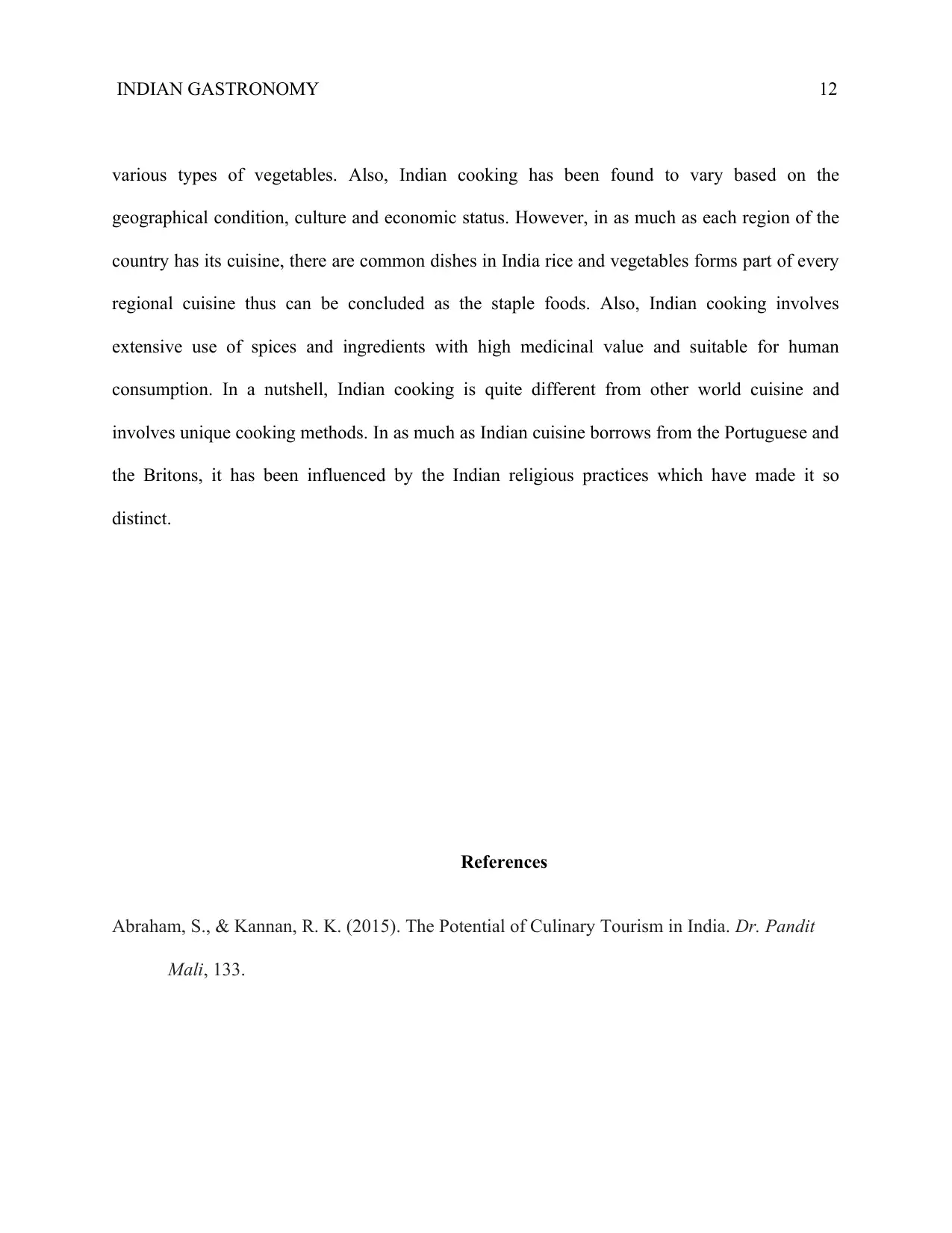
INDIAN GASTRONOMY 12
various types of vegetables. Also, Indian cooking has been found to vary based on the
geographical condition, culture and economic status. However, in as much as each region of the
country has its cuisine, there are common dishes in India rice and vegetables forms part of every
regional cuisine thus can be concluded as the staple foods. Also, Indian cooking involves
extensive use of spices and ingredients with high medicinal value and suitable for human
consumption. In a nutshell, Indian cooking is quite different from other world cuisine and
involves unique cooking methods. In as much as Indian cuisine borrows from the Portuguese and
the Britons, it has been influenced by the Indian religious practices which have made it so
distinct.
References
Abraham, S., & Kannan, R. K. (2015). The Potential of Culinary Tourism in India. Dr. Pandit
Mali, 133.
various types of vegetables. Also, Indian cooking has been found to vary based on the
geographical condition, culture and economic status. However, in as much as each region of the
country has its cuisine, there are common dishes in India rice and vegetables forms part of every
regional cuisine thus can be concluded as the staple foods. Also, Indian cooking involves
extensive use of spices and ingredients with high medicinal value and suitable for human
consumption. In a nutshell, Indian cooking is quite different from other world cuisine and
involves unique cooking methods. In as much as Indian cuisine borrows from the Portuguese and
the Britons, it has been influenced by the Indian religious practices which have made it so
distinct.
References
Abraham, S., & Kannan, R. K. (2015). The Potential of Culinary Tourism in India. Dr. Pandit
Mali, 133.
⊘ This is a preview!⊘
Do you want full access?
Subscribe today to unlock all pages.

Trusted by 1+ million students worldwide
1 out of 15
Your All-in-One AI-Powered Toolkit for Academic Success.
+13062052269
info@desklib.com
Available 24*7 on WhatsApp / Email
![[object Object]](/_next/static/media/star-bottom.7253800d.svg)
Unlock your academic potential
Copyright © 2020–2025 A2Z Services. All Rights Reserved. Developed and managed by ZUCOL.
